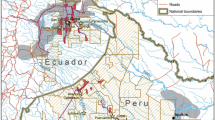Abstract
Objective: This study was undertaken to evaluate the environmental exposure to polycyclic aromatic hydrocarbons (PAHs) in nonsmoking adult subjects living in the vicinity of a creosote impregnation plant in Delson, Canada. Urinary metabolites of naphthalene, α- and β-naphthol, and pyrene metabolite 1-hydroxypyrene (1-OHP), were used as biomarkers of exposure. Methods: Morning and evening urine samples were collected in mid-August from 30 exposed individuals living at a distance of 50–360 m downwind of the plant and from a control group in the adjoining municipality residing at a distance of 1.9–2.7 km upwind of the plant. Metabolites were measured by gas chromatography/mass spectrometry. Results: Excretion values of α- and β-naphthol were significantly higher in the exposed group than in controls (P < 0.04), after accounting for possible confounding variables by multivariate analyses. The respective geometric mean concentrations (5th and 95th percentiles) of α-naphthol for the exposed and nonexposed groups were 2.04 (0.55–6.00) and 1.37 (0.39–7.02) μmol/mol creatinine for evening samples, and 2.49 (0.77–8.43) and 1.17 (0.37–6.88) μmol/mol creatinine for morning samples. Corresponding values for β-naphthol were 1.78 (0.82–3.67) and 1.36 (0.63–5.07) μmol/mol creatinine for evening samples, and 1.94 (1.03–4.96) and 1.08 (0.49–5.05) μmol/mol creatinine for morning samples. On the other hand, no significant difference in 1-OHP excretion was observed between the exposed and the control group (P>0.5). The respective geometric mean concentrations (5th and 95th percentiles) of 1-OHP for these groups were 0.05 (0.01–0.17) and 0.06 (0.01–0.48) μmol/mol creatinine for evening samples, and 0.05 (0.02–0.12) and 0.05 (0.01–0.42) μmol/mol creatinine for morning samples. Conclusions: The measurement of α- and β-naphthol urinary concentrations appears to be an approach sufficiently sensitive to reveal differences in low exposure levels of volatile PAHs due to creosote impregnation plant emissions. However, uptake of pyrene due to the plant was too small to contribute significantly to 1-OHP excretion.
Similar content being viewed by others
Author information
Authors and Affiliations
Additional information
Received: 13 June 2000 / Accepted: 21 April 2001
Rights and permissions
About this article
Cite this article
Bouchard, M., Pinsonneault, L., Tremblay, C. et al. Biological monitoring of environmental exposure to polycyclic aromatic hydrocarbons in subjects living in the vicinity of a creosote impregnation plant. Int Arch Occup Environ Health 74, 505–513 (2001). https://doi.org/10.1007/s004200100251
Issue Date:
DOI: https://doi.org/10.1007/s004200100251




